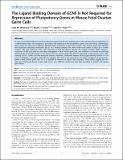| dc.contributor.author | Okumura, Leah M. | |
| dc.contributor.author | Lesch, Bluma J. | |
| dc.contributor.author | Page, David C. | |
| dc.date.accessioned | 2013-09-26T19:51:17Z | |
| dc.date.available | 2013-09-26T19:51:17Z | |
| dc.date.issued | 2013-06 | |
| dc.date.submitted | 2013-02 | |
| dc.identifier.issn | 1932-6203 | |
| dc.identifier.uri | http://hdl.handle.net/1721.1/81204 | |
| dc.description.abstract | In mice, successful development and reproduction require that all cells, including germ cells, transition from a pluripotent to a differentiated state. This transition is associated with silencing of the pluripotency genes Oct4 and Nanog. Interestingly, these genes are repressed at different developmental timepoints in germ and somatic cells. Ovarian germ cells maintain their expression until about embryonic day (E) 14.5, whereas somatic cells silence them much earlier, at about E8.0. In both somatic cells and embryonic stem cells, silencing of Oct4 and Nanog requires the nuclear receptor GCNF. However, expression of the Gcnf gene has not been investigated in fetal ovarian germ cells, and whether it is required for silencing Oct4 and Nanog in that context is not known. Here we demonstrate that Gcnf is expressed in fetal ovarian germ cells, peaking at E14.5, when Oct4 and Nanog are silenced. However, conditional ablation of the ligand-binding domain of Gcnf using a ubiquitous, tamoxifen-inducible Cre indicates that Gcnf is not required for the down-regulation of pluripotency genes in fetal ovarian germ cells, nor is it required for initiation of meiosis and oogenesis. These results suggest that the silencing of Oct4 and Nanog in germ cells occurs via a different mechanism from that operating in somatic cells during gastrulation. | en_US |
| dc.description.sponsorship | Howard Hughes Medical Institute | en_US |
| dc.description.sponsorship | National Institutes of Health (U.S.) (2R01HG00257-20) | en_US |
| dc.description.sponsorship | National Human Genome Research Institute (U.S.) (2R01HG00257-20) | en_US |
| dc.language.iso | en_US | |
| dc.publisher | Public Library of Science | en_US |
| dc.relation.isversionof | http://dx.doi.org/10.1371/journal.pone.0066062 | en_US |
| dc.rights | Creative Commons Attribution | en_US |
| dc.rights.uri | http://creativecommons.org/licenses/by/2.5/ | en_US |
| dc.source | PLoS | en_US |
| dc.title | The Ligand Binding Domain of GCNF Is Not Required for Repression of Pluripotency Genes in Mouse Fetal Ovarian Germ Cells | en_US |
| dc.type | Article | en_US |
| dc.identifier.citation | Okumura, Leah M., Bluma J. Lesch, and David C. Page. The Ligand Binding Domain of GCNF Is Not Required for Repression of Pluripotency Genes in Mouse Fetal Ovarian Germ Cells. Edited by Gabriel Livera. PLoS ONE 8, no. 6 (June 7, 2013): e66062. . | en_US |
| dc.contributor.department | Massachusetts Institute of Technology. Department of Biology | en_US |
| dc.contributor.department | Whitehead Institute for Biomedical Research | en_US |
| dc.contributor.mitauthor | Okumura, Leah M. | en_US |
| dc.contributor.mitauthor | Lesch, Bluma | en_US |
| dc.contributor.mitauthor | Page, David C. | en_US |
| dc.relation.journal | PLoS ONE | en_US |
| dc.eprint.version | Final published version | en_US |
| dc.type.uri | http://purl.org/eprint/type/JournalArticle | en_US |
| eprint.status | http://purl.org/eprint/status/PeerReviewed | en_US |
| dspace.orderedauthors | Okumura, Leah M.; Lesch, Bluma J.; Page, David C. | en_US |
| dc.identifier.orcid | https://orcid.org/0000-0001-9920-3411 | |
| dspace.mitauthor.error | true | |
| mit.license | PUBLISHER_CC | en_US |
| mit.metadata.status | Complete | |
